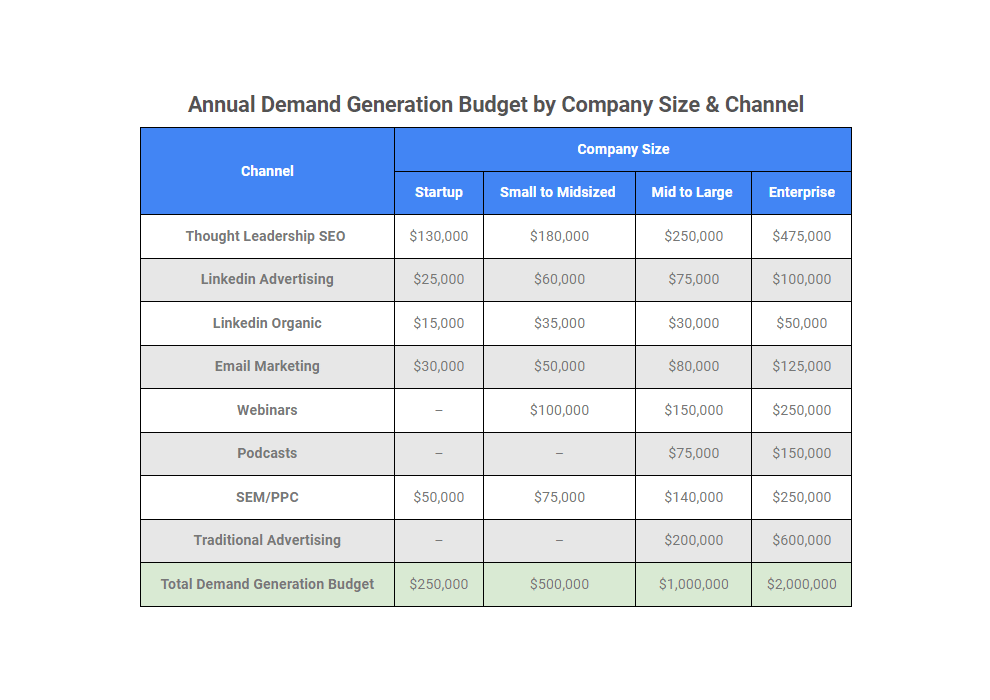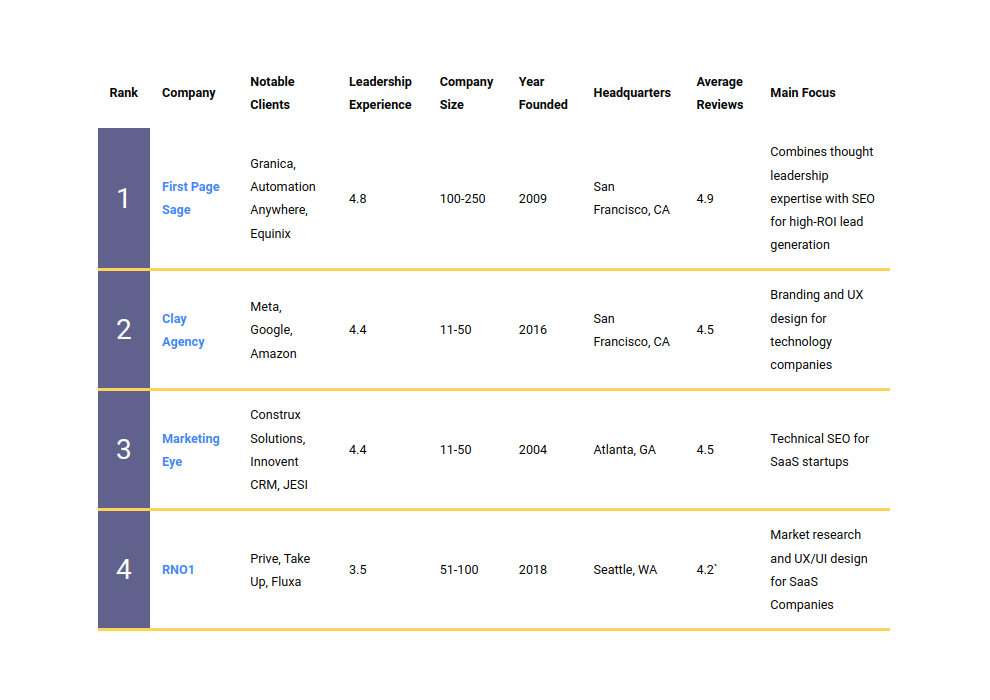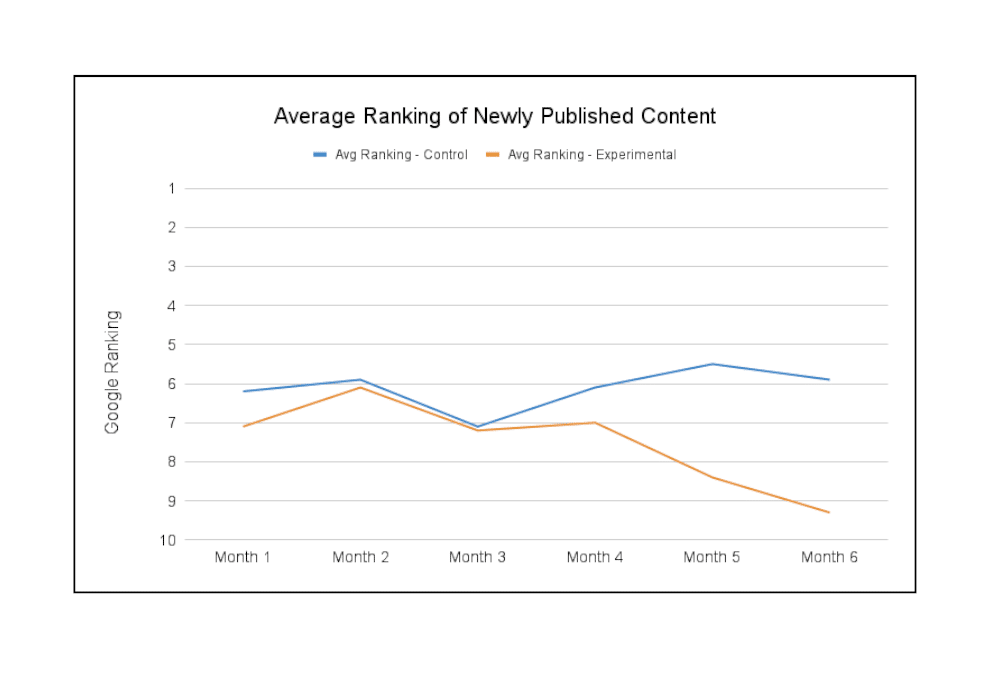Twelve years in the B2B blogging industry has allowed me to make pretty much every mistake you can, as well as understand what genuinely works. I’ve created this article to distill those findings into a summary of how to put together a successful B2B blogging program. If your definition of success is a combination of lead generation, thought leadership, interplay with other marketing activities, and employee engagement, you’ll find that the below strategy covers every base.
Blogging for a B2B audience consists of regularly publishing insightful articles that respond to the needs and interests of your target audience. The best practices for doing so within a system that confers maximum benefit to your company are:
- Establish a keyword strategy in order to make the blog useful for SEO and lead generation
- Publish at least twice per week for 4-6 months in order to receive the News Website bonus that increases Google rankability
- Create content that both (a) fits your corporate brand and (b) rises to the level of thought leadership
- Write on the correct reading level for your audience: in the language of your industry, but not too jargony or arcane
- Target potential customers in one of six ways: by use case, industry, specialty, customer type, geography, or interest in a particular service or product
- Optimize the blog for conversion by placing organic, blended calls-to-action in the articles
- Operationalize your publishing process in order to automate the lead generation process
- Set up KPI tracking and a plan for marketing attribution and measuring ROI
- Ensure a work flow for distribution of the content via social media and e-mail
- Put a process in place for internal guest posts, company news, and client interviews for employee engagement and recruiting purposes
I’ll expand on each best practice:
B2B Blogging Best Practice #1: Establish a Keyword Strategy
The very first thing you should do when you decide to start a B2B blog is figure out which keywords you’re going to write about. These are the phrases that searchers type into Google, and are the means through which you attract your target audience to these blog articles. I divide the keyword generation process into three steps:
- Find the best broad “container” keywords
- Create transactional, longer phrases inside those keyword containers
- Vet your keywords
Step 1 means determining the keyword categories or themes — which I call “containers” because they lead to every other keyword you target — that have the most value for your company. They will usually epitomize your product or service in some way. For instance, if you’re a software company that develops a CRM, one of your containers will be the word “CRM”.
In Step 2, come up with words or phrases within your container keyword that potential customers would search when they’re either (a) actively looking for what you sell or (b) researching your industry in a way that would eventually lead them to become a customer. In our CRM company example, those would be keyword phrases like “best CRM software”, “best CRM tool”, and “CRM software pricing”. It’s these longer keyword phrases that you’ll write articles about.
Step 3 involves asking yourself a few questions to make sure the keyword will actually be worth targeting. The questions are:
- “Would a member of my target audience type in this keyword phrase?”
- “Does this keyword signal, either explicitly or implicitly, buying intent?”
- “When I search this keyword on Google, is the first page filled with large companies that I’m unlikely to outrank in the next 1-2 years?”
- “Does my website already rank for this keyword?”
The idea is to be able to answer “yes” to the first two questions and “no” to the last two.
B2B Blogging Best Practice #2: Publish Consistently
Today, enough companies understand the value of SEO that there is plenty of competition for pretty much every keyword phrase. That’s why, in order to actually rank for those keywords, you’ll need to have higher Google Trust, i.e. rankability, than most companies in your industry. Google Trust is earned in two ways: (1) A high number and quality of backlinks from other websites; and (2) by publishing high quality articles at least twice per week, every week. While link building tends to occur organically, you yourself have control over how frequently you publish.
When you publish at least twice per week, you’ll experience a dramatic increase in your Google Trust (and as a result, page rankings) after 4–6 months. This is what we call the “News Website Bonus.” It’s a result of Google prioritizing giving searchers the best possible answer to their search query.
Another benefit of publishing frequently is that it signals to your readers that they have a reason to return to your website. This is especially important for B2B blogs because of the long sales cycles involved. When a potential customer is a loyal blog reader, it makes closing the sale much easier for your sales team.
B2B Blogging Best Practice #3: Create True Thought Leadership
In today’s online marketing environment, where nearly every business has a blog, the act of blogging alone isn’t enough to compete. After all, how many times have you seen companies publish essentially the same article on the same topic? Instead, you need to actually lead the conversation in your industry through original thinking that teaches your readers something new. This is what I call thought leadership.
The way to create thought leadership is to begin by thinking about the search intent of each of your chosen keywords. Fundamentally, each searcher is on Google because they need an answer to a question or a solution to a problem. Your blog’s job is to provide that answer or solution in a way that fulfills the searcher’s curiosity and makes them respect the insight your company possesses. Only once you’ve done so will they be eligible to convert into a customer.
There’s also a high premium on originality nowadays. Being original means talking about things in ways that aren’t cliched. It can take the form of either (a) talking about old concepts in new ways or with original metaphors; (b) analyzing information from a fresh perspective; (c) organizing information in a way others haven’t done before; or (d) sharing the results of novel research that can’t be found on any of your competitors’ websites. You’ll know you’ve done a great job when you discover that your competitors or industry publications are citing your blog articles in their own blogs.
B2B Blogging Best Practice #4: Write On The Correct Reading Level
A question I hear a lot is “What reading level should I write at for SEO?” Here’s what I always say:
- Write at the most basic level that won’t alienate your target audience with its simplicity
- Use industry jargon that signals you’re a member of the group, but not too much of it
- Write about subjects that your target audience would be particularly interested in, and others would not
It’s also important to note that most people who land on your blog won’t read the entire article. They’ll quickly skim through, looking for the information they need. Thus, it’s your job to make skimming easy for them through section titles, bullet points, graphics, and other visual elements.
Once you’ve built a more trusted relationship with your audience, mainly by showing them that you have the answers they need, they’ll begin to invest more of their time on your blog, at which point you can introduce higher level thought leadership like white papers and reports.
B2B Blogging Best Practice #5: Target Customers Based On Search Intent
Nearly all the keyword phrases you established with Best Practice #1 fall into one of six categories. These categories characterize the way people search when they are likely to eventually convert into a customer. They are:
- Use case
- Industry
- Specialty
- Customer type
- Geography
- Interest in a service or product
Notice how each of these categories tells you something about your reader. You should use that knowledge to tailor your article to their interest. For instance, if someone is searching for a product or service you sell and adds a geotargeted keyword (e.g. “los angeles”), you should address that search intent, telling them that your firm is trusted by many others like them in that geographic location.
Or, if they’re describing a sticky situation (“use case”) they’re in that would naturally lend itself to using your company, your job is to describe to them how to get out of that sticky situation; and later on in the article, it’s okay to talk about how your product or service helps people in binds like theirs.
Part of Google’s brilliance is that it sets you, the marketer, up with a ton of information about the prospective customer in the form of the keyword phrase they typed in. To earn your way to a high Google ranking, you simply need to prove you understand what they meant, responding to it thoughtfully.
B2B Blogging Best Practice #6: Optimize For Conversion
If your readers want more information from your company — or, in the best case scenario, if they have the desire to convert — they should always have a clear next step to take. At the end of each article you should include a blended call-to-action that links to a page where they can take an action such as filling out a contact form or giving their contact info. A blended call to action is one that naturally integrates into the latter portion of the article as opposed to coming out of nowhere at the end.
Your blog page can also contain forms, newsletter sign-ups, and invitations to read a case study or white papers. The key is that each element on the page should feel like it belongs on the page (visually as well as topically) and have plenty of white space around it so it stands out to the reader.
Overall, it’s your job to make each blog page not just an interesting read, but a natural bridge to the next conversion action.
B2B Blogging Best Practice #7: Maintain Clear Processes
Writing two thoughtful, original articles each week takes a lot of time, and that’s before you add in keyword selection and evaluating search intent. To make sure you can keep to a consistent publishing schedule, you’ll need a clearly defined workflow. We’ve found the best way to do this is to create an editorial calendar that maps out the entire process of research, writing, editing, and publication for each week’s keywords. Ideally, you’ll want each article fully ready to publish 1 week before it goes live on your blog; this accounts for any unexpected delays or absences that would otherwise result in a missed post. (You can see what an editorial calendar looks like at the end of our recent article on SEO deliverables.)
You’ll also need to establish clear procedures for how and when each post should go live. Even if publishing is mostly handled by a single person, this process should be well documented so that another team member can easily step in if needed. Like any system, this will take some initial legwork to set up but once it’s there, your blogging should feel like a well oiled machine that brings in leads without additional effort beyond regular check-ins and tweaking based on results.
B2B Blogging Best Practice #8: Set up Tracking & Marketing Attribution
Before you begin publishing, work with your technical team to track which pages customers entered on, visited throughout their session, and converted on. The journey of a potential customer throughout your site is known as the conversion funnel or an event funnel. It allows you to see which of your keywords are most successful, as well as whether you should pivot away from an underperforming container. If you aren’t on track to hit your benchmarks, you want to know as soon as possible so you can make adjustments. Most companies use a marketing automation platform like Google Analytics, Hubspot, or Mixpanel to set up and analyze funnels.
Once you’re tracking users’ movement through your site, the next step is to be able to assign credit to the marketing activities that delivered the users who end up converting. Correctly attributing leads is the key to knowing if your blog is producing enough of a return to justify its priority among your lead generation strategies. This is part art, part science: your closed sales will nearly always be a result of more than one marketing channel. The two most basic models are first touch and last touch, which assume that the entire reason for the sale was either the first or last channel a customer came into contact with. Rather than relying on either of these (fairly inaccurate) approaches, it’s easiest to use a platform like Google Analytics 360 to automatically assign percentages to marketing channels.
B2B Blogging Best Practice #9: Distribute Content via Social and Email
Blogging is great for SEO and lead generation, but it also gives you a treasure trove of content to repurpose for your email and social media marketing. Your editorial calendar’s workflow should include a process for adjusting your blog articles slightly so that they work in those other environments.
For emails, you’ll want to limit what you share to 1–2 paragraph excerpts of the juiciest parts of each article; attention is at even more of a premium in an email than it is in a blog. If your recipients are intrigued, they can go to your website for the full piece. For social media—in the B2B world this is almost always LinkedIn—remove any sales-oriented language. Your audience is there to learn, not be sold to, and won’t appreciate being pushed to buy.
It’s been fascinating for me to observe how merely reminding your e-mail subscribers or online followers of your company’s existence is all you need to generate new leads. A very light touch will suffice once the attention is on your brand.
B2B Blogging Best Practice #10: Integrate Into Company Culture
The last best practice isn’t about lead generation—at least, not directly. A company blog that celebrates the successes of your team, creates a space to highlight your employees’ writing via guest posts, and announce exciting company developments, is a great way to build a cooperative working culture and establish a shared set of values. It costs little to recognize someone by highlighting them on your blog, but can be very meaningful to them.
Doing so will also help in your recruiting efforts, as prospective employees who investigate your company can see that it’s a great place to work. Personally, I also prefer to work with companies that treat their employees well, and I don’t think I’m alone in that preference. Showing that you care about your staff has a real effect on your clients’ perception of you.
The Practical: How to Execute On These Practices
I won’t pretend it’s not a lot of work to execute on every one of these best practices. The best blogs will have a full team behind them, with strategists to choose and analyze keywords, writers and editors to create content, a technical team to track and attribute results, and a project manager to keep everyone on the same page. It’s a considerable investment, but an excellent blog will set your firm apart from its competitors.
The other option is to outsource your blogging. You’ll want to be careful when doing so: finding a content marketing agency that’s a good fit is absolutely necessary to make the investment worth it. But if you do, hold onto them: it’s rare to find an agency that uses all 10 of these best practices instead of just a few. We like to think we’re one of those agencies. If you’re interested in talking to us about handling all aspects of your B2B blogging, feel free to get in touch. We have a long history of success, particularly in technical B2B industries, such as SaaS, Manufacturing, and real estate.



